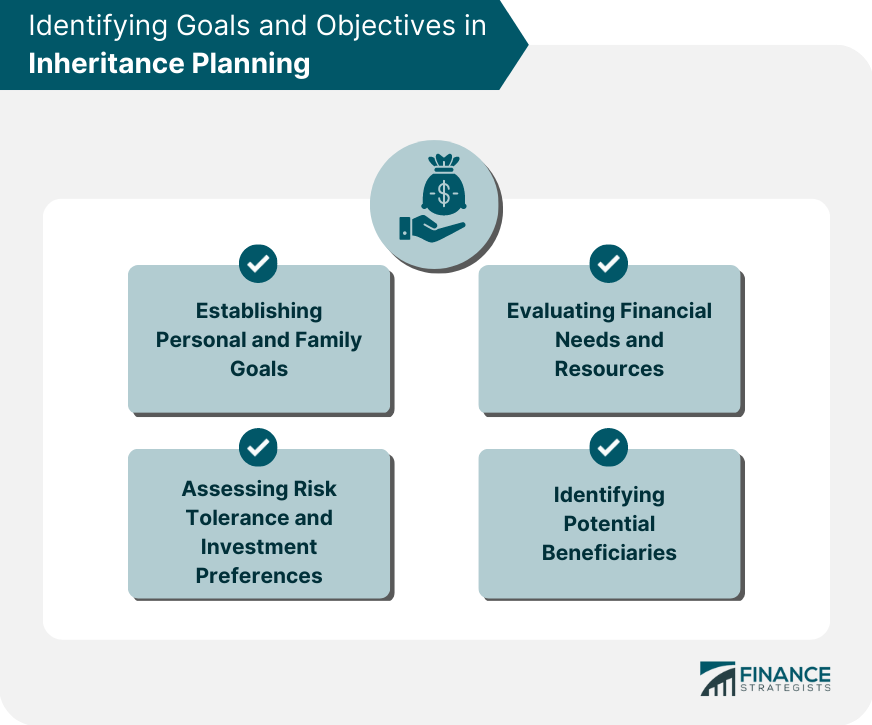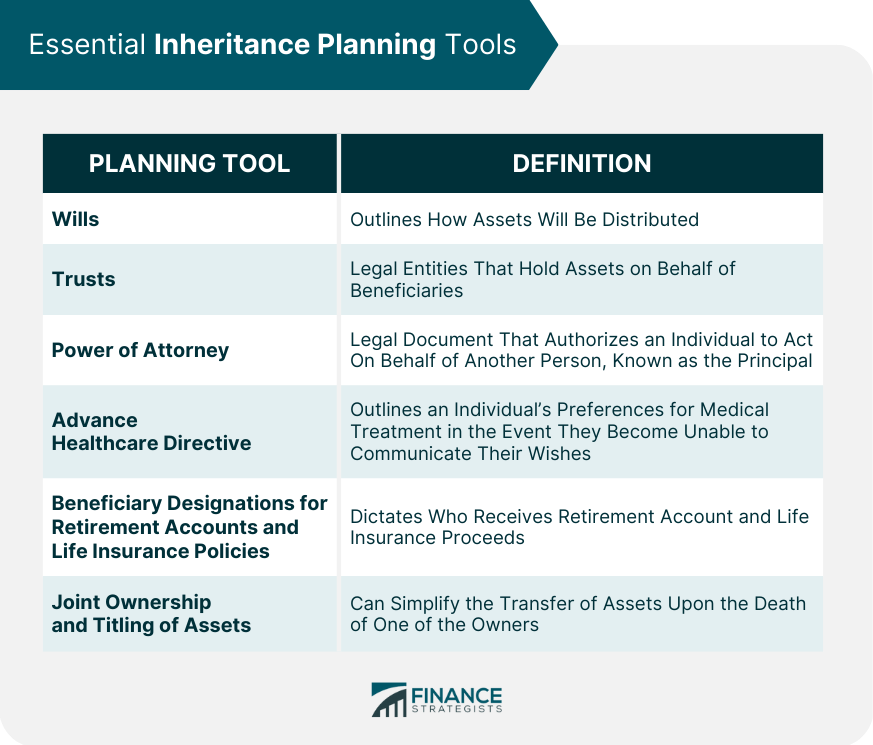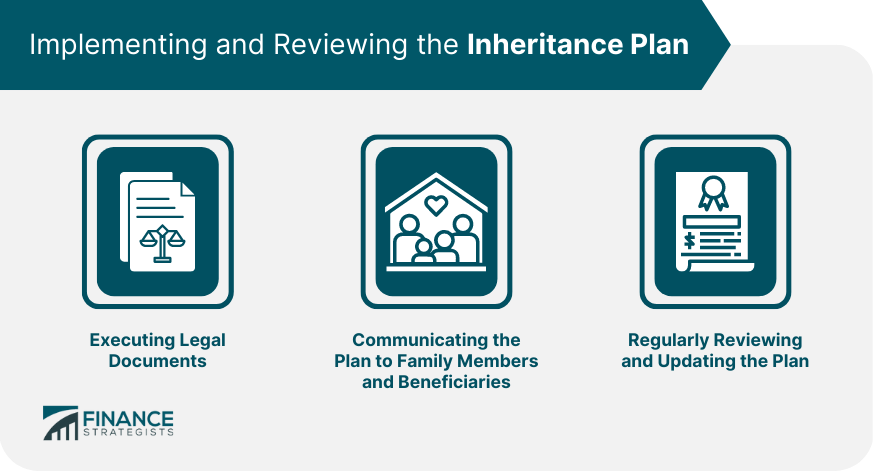Inheritance planning is the process of preparing for the transfer of one's assets to beneficiaries upon their death. The primary objective of inheritance planning is to ensure that an individual's assets are transferred smoothly, efficiently, and cost-effectively to their intended beneficiaries while minimizing tax liabilities and maximizing the value of the estate. Inheritance planning involves the utilization of a variety of legal tools and strategies such as wills, trusts, beneficiary designations, joint ownership and titling of assets, and powers of attorney. These tools can help to avoid probate, which is a time-consuming and expensive legal process that may arise if an individual dies without a valid will or trust in place. Properly structured inheritance planning can also help to minimize estate taxes, protect assets from creditors, and provide for the management and distribution of assets. Inheritance planning also involves reviewing and updating estate planning documents on a regular basis to ensure that they remain current and reflect an individual's wishes.
The first step in inheritance planning is to establish personal and family goals. This may include providing for a spouse or partner, ensuring the financial well-being of children and other dependents, or supporting charitable organizations. It is crucial to have a clear understanding of these goals to create an effective inheritance plan. An individual must evaluate their financial needs and resources to develop a realistic plan. This assessment includes reviewing current assets, debts, income sources, and expected future expenses. Understanding the current financial situation allows for the creation of a plan that meets both current and future needs. Risk tolerance and investment preferences play a significant role in inheritance planning. An individual's comfort level with different types of investments and their potential risk can impact the structure of the inheritance plan. Understanding these preferences allows for the creation of a plan that aligns with the individual's risk tolerance and investment objectives. Potential beneficiaries include family members, friends, or organizations that the individual wishes to support financially. Identifying these beneficiaries is crucial, as it helps to ensure that the inheritance plan aligns with the individual's wishes and intentions. Inheritance planning must take into account federal and state regulations that govern the transfer of wealth and assets upon death. These laws can be complex and may vary depending on the jurisdiction. Intestacy laws, which apply when an individual dies without a will, are also essential to understand, as they may impact the distribution of assets. Taxes play a significant role in inheritance planning. The three primary taxes to consider are estate tax, gift tax, and income tax. Each of these taxes can impact the value of the assets transferred to beneficiaries and should be considered when developing a plan. Various strategies can be employed to minimize the tax burden associated with inheritance planning. These strategies may include utilizing trusts, making charitable donations, and taking advantage of lifetime gift tax exclusions. A tax professional can provide guidance on the best strategies for an individual's specific situation. A will is a legal document that outlines how an individual's assets will be distributed upon their death. Wills can be simple or complex, depending on the individual's needs and preferences. Regularly reviewing and updating a will is crucial to ensure that it remains current and reflects the individual's wishes. Trusts are legal entities that hold assets on behalf of beneficiaries. There are various types of trusts, each with its benefits and drawbacks. Trusts can offer tax benefits, provide for the management of assets, and protect assets from potential creditors. A power of attorney is a legal document that authorizes an individual, known as the agent, to act on behalf of another person, known as the principal. This authority may include making financial or healthcare decisions when the principal is unable to do so. An advance healthcare directive, also known as a living will, is a legal document that outlines an individual's preferences for medical treatment in the event they become unable to communicate their wishes. Beneficiary designations are an essential part of inheritance planning, as they dictate who will receive the proceeds of retirement accounts and life insurance policies upon the account holder's death. Ensuring that beneficiary designations are up-to-date and aligned with the individual's wishes is crucial for effective inheritance planning. Joint ownership of assets, such as real estate or financial accounts, can simplify the transfer of these assets upon the death of one of the owners. Properly titling assets can help avoid probate and ensure a smoother transition of assets to the intended beneficiaries. Estate planning attorneys, financial planners, and tax advisors all play essential roles in the inheritance planning process. Each professional brings specific expertise to the table, helping individuals navigate the complexities of inheritance planning and ensure that their plans align with their goals and objectives. Choosing the right professionals to assist in inheritance planning is vital. Individuals should look for professionals with experience and credentials relevant to their specific needs. Recommendations from friends, family, or other professionals can be a valuable resource in finding the right team. Working closely with estate planning professionals ensures that all aspects of the inheritance plan are considered and that the plan remains up-to-date and aligned with the individual's goals. Regular communication and collaboration are essential for effective inheritance planning. Once the inheritance plan has been developed, it is essential to execute the necessary legal documents, such as wills, trusts, and powers of attorney. Proper execution ensures that the plan will be legally enforceable and carried out as intended. Communication is a crucial aspect of inheritance planning. Sharing the plan with family members and beneficiaries can help avoid misunderstandings and potential disputes. Open and honest communication can also foster a greater sense of trust and support among loved ones. Life events and changes in circumstances, such as marriage, divorce, the birth of a child, or changes in financial status, can impact an individual's inheritance plan. Additionally, changes in tax laws and regulations may also necessitate updates to the plan. Regularly reviewing and updating the inheritance plan ensures that it remains current and effective. Proactive inheritance planning is essential for ensuring that an individual's assets and wealth are distributed according to their wishes, minimizing potential family disputes, and optimizing tax benefits. This comprehensive guide provides an overview of the critical components of inheritance planning, including goal setting, legal and tax considerations, essential planning tools, and collaboration with professional advisors. By engaging in ongoing dialogue and education in inheritance planning, individuals can provide security and peace of mind for themselves and their loved ones.What Is Inheritance Planning?
Identifying Goals and Objectives
Establishing Personal and Family Goals
Evaluating Financial Needs and Resources
Assessing Risk Tolerance and Investment Preferences
Identifying Potential Beneficiaries

Legal Framework and Tax Considerations
Overview of Inheritance Laws
Tax Implications
Strategies for Tax Minimization
Essential Inheritance Planning Tools
Wills
Trusts
Power of Attorney
Advance Healthcare Directive
Beneficiary Designations for Retirement Accounts and Life Insurance Policies
Joint Ownership and Titling of Assets

Estate and Financial Planning Professionals
Roles and Responsibilities
Finding and Selecting the Right Professionals
Collaborating With Your Team
Implementing and Reviewing the Inheritance Plan
Executing Legal Documents
Communicating the Plan to Family Members and Beneficiaries
Regularly Reviewing and Updating the Plan

Conclusion
Inheritance Planning FAQs
Inheritance planning refers to the process of arranging the transfer of assets from one generation to the next. It involves creating a plan to distribute one's assets and wealth after their death, while minimizing taxes and legal fees.
Inheritance planning is important because it allows an individual to have control over the distribution of their assets after their death. It can also help to minimize taxes, avoid disputes among beneficiaries, and protect assets from creditors.
There are several ways to distribute assets through inheritance planning, including creating a will, setting up trusts, and naming beneficiaries on retirement accounts and life insurance policies. The best approach depends on an individual's unique circumstances.
It is never too early to start inheritance planning. Ideally, it should begin as soon as an individual starts acquiring assets and wealth. However, it's never too late to create an inheritance plan, and it's important to review and update the plan periodically as circumstances change.
While it is possible to create a basic inheritance plan without a lawyer, it is recommended to seek the advice of an experienced estate planning attorney. They can help ensure that the plan is legally valid, minimize taxes and legal fees, and provide guidance on the best strategies for distributing assets.
True Tamplin is a published author, public speaker, CEO of UpDigital, and founder of Finance Strategists.
True is a Certified Educator in Personal Finance (CEPF®), author of The Handy Financial Ratios Guide, a member of the Society for Advancing Business Editing and Writing, contributes to his financial education site, Finance Strategists, and has spoken to various financial communities such as the CFA Institute, as well as university students like his Alma mater, Biola University, where he received a bachelor of science in business and data analytics.
To learn more about True, visit his personal website or view his author profiles on Amazon, Nasdaq and Forbes.















